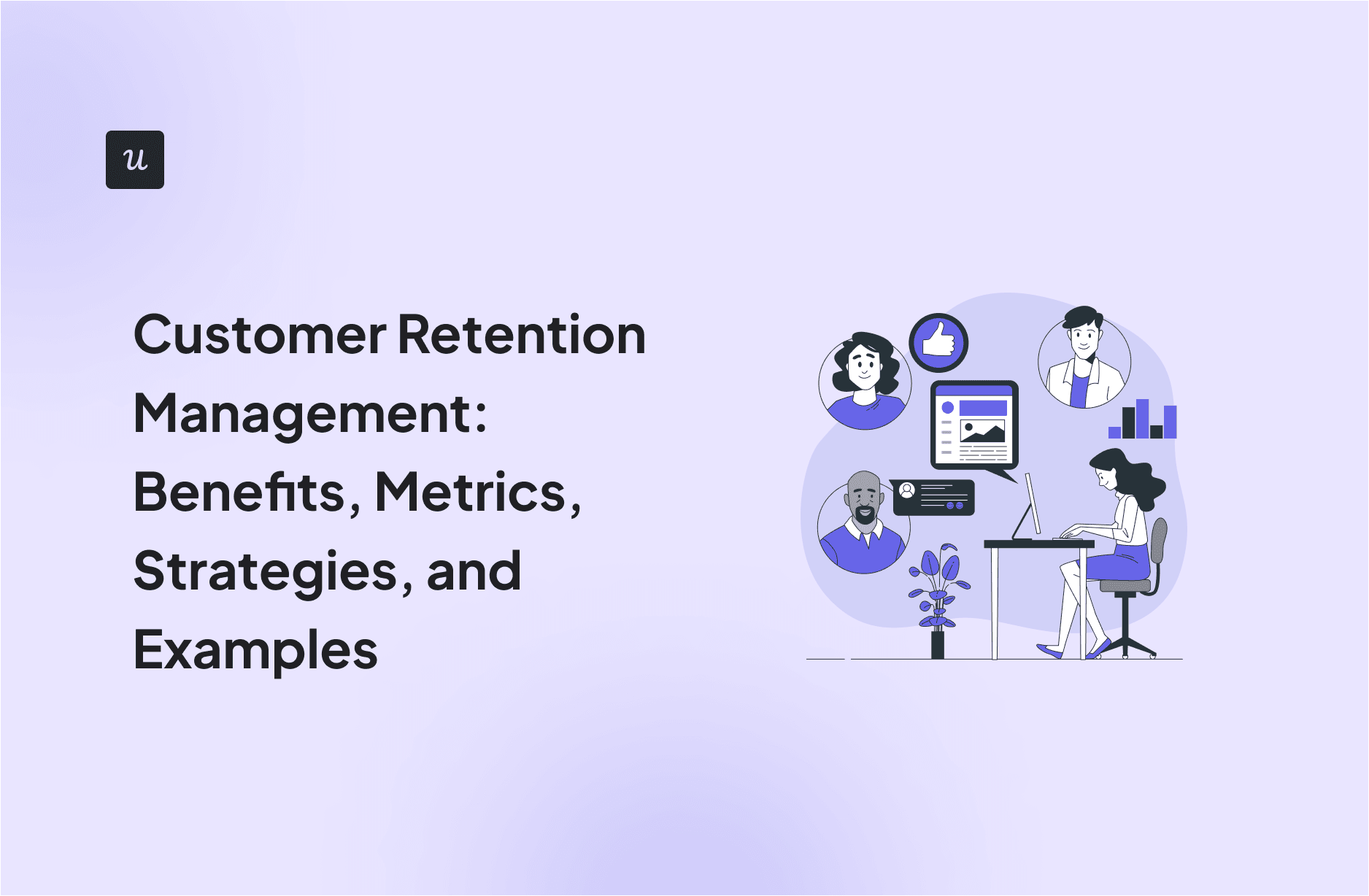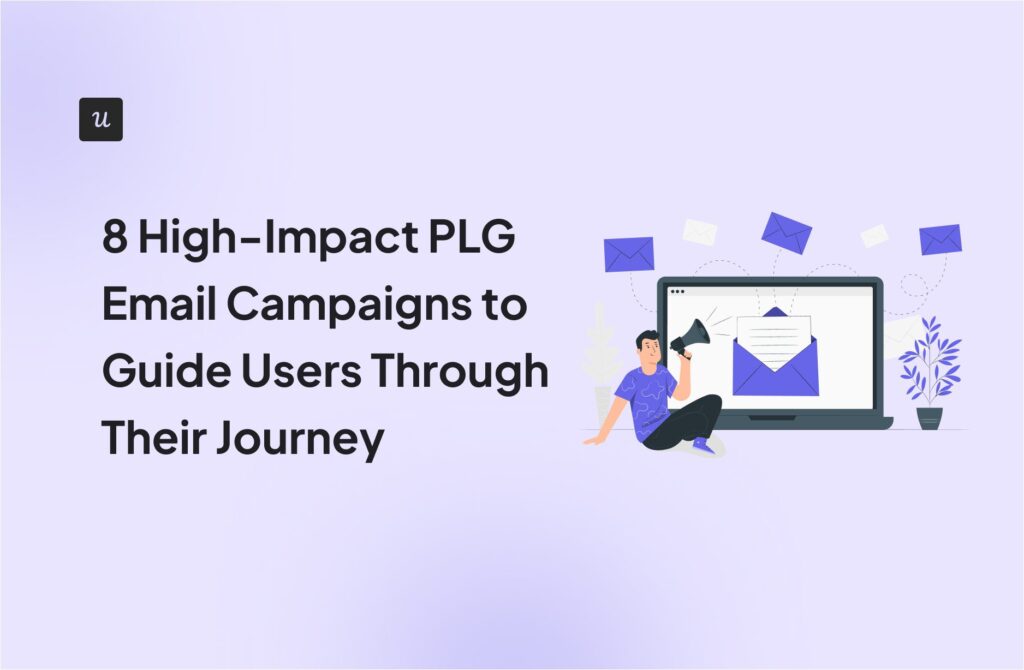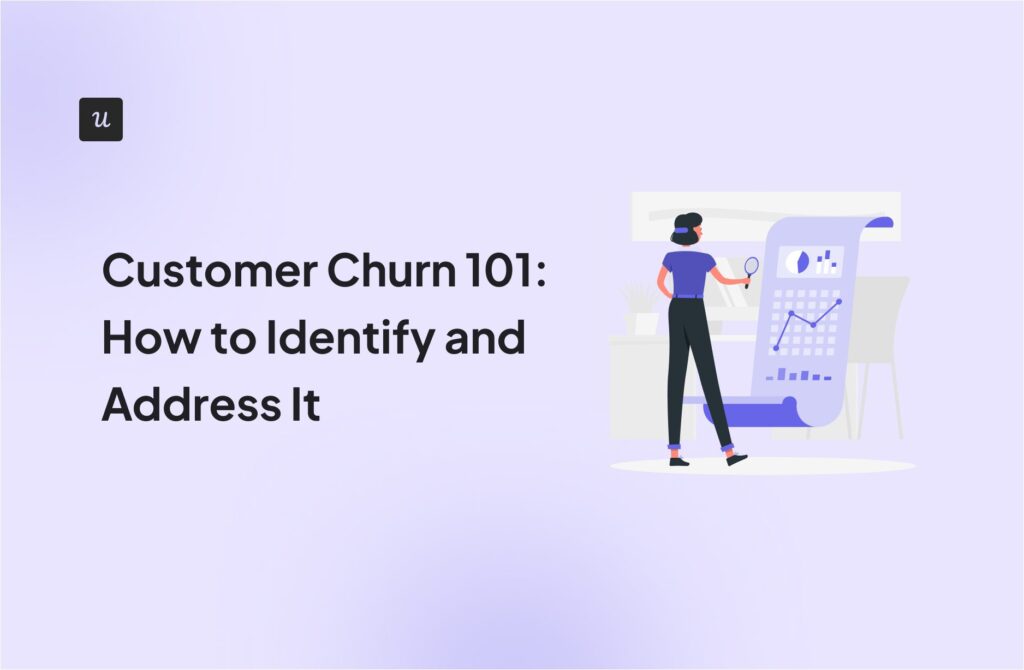
Customer Retention Management: Benefits, Metrics, Strategies, and Examples
Get The Insights!
The fastest way to learn about Product Growth, Management & Trends.
What is customer retention management?
Customer retention management is a strategy aimed at keeping customers engaged and loyal to a brand or company. It involves understanding and addressing customers’ needs to ensure user satisfaction and continued patronage.
The customer retention model refers to the specific approaches or actions taken to achieve this goal, focusing on building strong, lasting relationships with repeat customers and focusing on customer success.
Why is a customer retention management program important?
Understanding why a customer retention management program is essential is like recognizing the value of keeping good friends close. Let’s dive into why nurturing these customer relationships is a key to customer success for any business.
Results in greater cost efficiency
Investing in a customer retention program is more wallet-friendly than customer acquisition. Think of it this way: keeping your current customers happy and loyal costs less than the big hunt for new ones.
This approach reduces the pressure and expense of constant customer acquisition, allowing you to focus more on nurturing your existing relationships.
Increases lifetime value of existing customers
Focusing on customer retention can increase your existing customers’ lifetime value (LTV). These loyal customers are likely to spend extra time engaging with your services or products, making them prime candidates for upselling opportunities.
As they become more receptive to these offers, their LTV—a measure of their value over the entire duration of their relationship with your business—naturally increases.
Creates satisfied customers who later become brand advocates
When you put effort into customer retention strategies, you boost customer satisfaction. Happy and satisfied customers don’t just stick around—they also transform into powerful advocates for your brand.
Their enthusiasm about your product or service can lead to positive word-of-mouth, essentially doing the customer acquisition work for you. This cycle of customer advocacy reinforces your brand’s reputation.
How to calculate customer retention rate?
The customer retention rate shows the percentage of customers you retain over a specific period, excluding any new customers acquired during that time. Here’s a simple formula to help you figure it out:
Customer retention rate = (Number of paying users at the end of the period – number of users acquired during the period) / Total number of users at the beginning of the period x 100
Say you start April with 150 paying users. Over the month, you get 30 new users, but by the end of April, you have 160 paying users. Your calculation for the month’s customer retention rate would be:
Number of users at the end of April = 160
Number of new users acquired in April = 30
Total number of users at the beginning of April = 150
Using the formula: [(160 – 30) / 150] x 100, we get a customer retention rate of approximately 86.67%. This number tells you you’re doing a great job with customer success and retaining customers.

Important retention metrics to track
Keeping an eye on the right numbers is key to winning the user loyalty game. Focusing on customer retention, let’s explore the vital retention KPIs (Key Performance Indicators) that help you measure customer success and keep your customers returning for more.
Product stickiness
Product stickiness is a customer retention metric that measures how often customers engage with your product or service. This refers to making your offering so valuable that users regularly return to it. The formula for product stickiness is:
Stickiness = Daily Active Users (DAUs) / Monthly Active Users (MAUs)
An active user is someone who engages with your product. Daily Active Users (DAUs) are the number of unique users interacting with your product daily, while Monthly Active Users (MAUs) are the unique users over a month. A higher ratio means your product is ‘stickier,’ as many monthly users return daily.
For example, if you have 1,000 MAUs and 300 DAUs, your product stickiness would be 300/1000, resulting in a 30% stickiness metric. This suggests that 30% of your monthly users use your product daily.

Customer lifetime value
Customer Lifetime Value (LTV) is a customer retention metric that predicts the net profit attributed to a customer’s future relationship.
LTV optimization is about increasing the total amount a customer is expected to spend on your products or services during their relationship with your company.
The formula for calculating customer lifetime value is:
Customer lifetime value = Customer value * Average customer lifespan
Here, ‘customer value’ is determined by multiplying the average purchase value by the average purchase frequency rate. Then, this customer value is multiplied by the average customer lifespan—the typical time a customer continues to purchase from your business.
For example, if the average customer spends $50 per purchase and shops with you ten times a year (making the customer value $500), and the average customer lifespan is three years, the LTV would be $500 * 3, equating to $1,500.

Expansion MRR
Expansion Monthly Recurring Revenue (MRR) is a customer retention metric that indicates how much your revenue from existing customers has increased due to upsells or cross-sells.
Here’s how you calculate it:
Expansion MRR Rate = [(Expansion MRR at the end of the month – Expansion MRR at the beginning of the month) / Previous period revenue] x 100
For example, if at the beginning of the month, your expansion MRR was $1,000 and by the end of the month, it increased to $1,500, with the previous month’s revenue being $10,000, your Expansion MRR Rate would be: (1500 – 1000) / 10,000 x 100, resulting in a 5% Expansion MRR Rate.
This tells you how much your revenue from existing customers has grown and highlights the success of your efforts to increase the value they get from your products or services.

Net Promoter Score
Net Promoter Score (NPS) is a customer retention metric used to gauge customer loyalty and satisfaction. It measures how likely customers are to recommend your product or service to others.
The formula to calculate NPS is quite straightforward:
NPS = Percentage of promoters – Percentage of detractors
Customers respond to a single question, “How likely are you to recommend our company/product/service to a friend or colleague?” on a scale from 0 to 10. Those who respond with a score of 9 or 10 are labeled as ‘promoters’—loyal enthusiasts who will keep buying and referring others, fueling growth.
Those who respond with a score of 0 to 6 are ‘detractors’—unhappy customers who can damage your brand and impede growth through negative word-of-mouth. Responses 7 and 8 are given by ‘passives‘—satisfied but unenthusiastic customers vulnerable to competitive offerings.
To calculate NPS, you subtract the percentage of detractors from the percentage of promoters.
For example, if 70% of respondents are promoters and 10% are detractors, your NPS would be 60%. A higher NPS score points to loyal customers and a healthier business.

9 customer retention strategies that improve customer loyalty
Keep your customers coming back with these nine powerful customer retention strategies. Each strengthens user loyalty and turns casual buyers into lifelong fans.
1. Create personalized experiences to retain customers
Building a bond with your customers starts with a personalized touch, which is a fundamental step toward customer retention. Using a welcome survey to collect details like their industry, specific jobs to be done, and role, you can tailor the onboarding process to meet their unique needs.
Showcasing features and solutions that directly address their jobs to be done results in a personalized customer experience. This bespoke approach makes them feel understood and lays the foundation for a strong, lasting customer relationship.

2. Launch interactive walkthroughs to guide new users
An effective customer retention management strategy is crucial to turning new users into regulars. They need to experience the value of your product firsthand. Interactive walkthroughs are your virtual tour guides, helping users understand and appreciate what you offer.
They usually consist of onboarding checklists that outline step-by-step achievements, tooltips that provide helpful hints and feature explanations and guided tasks that lead users through the key functionalities.
By using these elements, customers can quickly grasp how your product fits into their workflow, enhancing their adoption and setting the stage to increase customer retention.

3. Gamify the in-app experience to engage customers
Spice up user onboarding and boost user engagement by turning it into a game. Introducing challenges, badges, and leaderboards makes using your app a playful and fun experience.
Reward your users for completing tasks or reaching new milestones within the app. These game-like elements can increase engagement, as users are motivated to explore and enjoy your app’s features more.
It’s a win-win: your customers have more fun, and you get to see your customer retention efforts and numbers climb.

4. Collect customer feedback regularly
Gathering customer feedback is like checking the pulse of your customer’s satisfaction – a critical component of customer retention management.
To improve CSAT (Customer Satisfaction Score), regular surveys should be used to tap into customer expectations and sentiment and pinpoint any hiccups in their experience. Here are a few examples of surveys to trigger:
- CSAT: Measures customer satisfaction with a service, product, or experience.
- NPS: Gauges the likelihood of customers recommending your service or product.
- CES (Customer Effort Score): Assesses how much effort a customer puts into using your product or resolving an issue.
Acting on the collected customer feedback and closing the feedback loop—where you inform customers how their input has shaped your services—solidifies trust and shows you value their voice. This cycle of listening and improving is essential for maintaining customer loyalty.

5. Remove friction points from the customer journey
Friction points are like roadblocks in your customer’s path—they can lead to a higher drop-off rate and, if too frequent, might cause customers to churn. To combat this, funnel analysis can be used to spot where potential customers lose interest or abandon their journey.

Complement this customer data with session recordings to better understand customer behavior and interactions. By identifying and removing these friction points, you streamline the customer experience, keeping the journey smooth and the customers engaged all the way through.
6. Announce new features to consistently increase product value
Adding value to your product is a dynamic process; it means regularly rolling out new features that resonate with your customers’ evolving needs.
To keep customers in the loop and excited about what’s new, announce these additions in a way that highlights their relevance to the users’ specific use cases.
But don’t stop at just announcing—offer webinars and in-app guides to walk customers through these new features, ensuring they understand and adopt them seamlessly into their daily routines. This ongoing demonstration of added value is key to customer retention management.

7. Offer self-service support to improve customer retention
Empower your customers with self-service solutions to find answers whenever they need them. Since your customers span various time zones, providing round-the-clock live support can be challenging and costly.
Instead, create a comprehensive resource center with user documentation, onboarding videos, and links to community forums.
These resources enable customers to solve problems at their convenience, boosting their confidence in using your product and enhancing their overall satisfaction and likelihood to stick around.

8. Reward loyal customers with loyalty programs and incentives
To cultivate customer loyalty, consider the adage, “Give and you shall receive.”
Show your customers they’re valued by offering loyalty programs and rewards such as discounts, access to premium features, or invitations to exclusive events.
These gestures make customers feel special and acknowledged, a cornerstone of customer retention management. When customers see that their commitment to your brand comes with benefits, they’re more likely to continue choosing you over competitors.

9. Identify at-risk customers and proactively engage them
Spotting at-risk customers early on is crucial for preventing churn. You can identify who might be on the verge of leaving by monitoring indicators like low NPS scores, decreased in-app activity, or actions that historically lead to churn.
Once identified, it’s important to proactively engage these customers.
Reach out, inquire about their challenges, and express a genuine desire to enhance their experience. This shows that you value their business and gives you a chance to turn the customer experience around, leveraging churn prediction insights to keep them within the fold.

Examples of companies with successful customer retention programs
Dive into customer retention examples where companies have set the bar high. These success stories showcase innovative retention management that has kept customers loyal and turned them into passionate advocates for the brand.
Attention Insight created an interactive walkthrough for new customers
Attention Insight improved customer activation by 47% using Userpilot’s interactive walkthroughs as part of its retention management. They introduced a step-by-step guide for new users to create heatmap analyses and tag “Areas of Interest.”
This approach involved:
- A welcome screen with tutorial videos.
- An interactive flow to guide users through the initial setup.
- An onboarding checklist.
- Dedicated flows for feature highlights.
- And, contextual education.
These measures significantly increased engagement and familiarity with key product features, demonstrating a successful onboarding strategy that led to higher user activation rates.

Groupize gamified the onboarding experience
Groupize gamified their onboarding experience by introducing “G.G.” (aka Groupize Guide) through Userpilot. This innovative assistant helped users navigate the app with onboarding tours, checklists, live chat, and other resources, making the learning process engaging and interactive.
By making G.G. accessible but not intrusive, Groupize optimized user engagement without overwhelming them. The implementation led to more directed and focused support tickets, indicating users effectively used G.G. for help before contacting customer service.

Osano provided an in-app resource center
Osano enhanced its customer retention strategy by introducing an in-app resource center using Userpilot. This resource center provides users with self-service support directly within the app, including help articles and tutorials.
By implementing this solution, Osano saw a 25% reduction in support chat requests. This customer retention strategy helped reduce delinquent churn and empowered users to find solutions independently, improving their overall experience with the product.

Userpilot announced new features in-app
Userpilot effectively announced their new Company Profiles feature through an in-app slideout, a method less intrusive than modals.
This approach, combined with a clear microcopy, ensures that users can learn about and understand the new feature without disrupting their workflow, enhancing the feature release’s impact.

Conclusion
Customer retention is an important metric to monitor in your business. It prevents you from relying completely on customer acquisition because customers stay and continue to provide you with revenue.
If you want to implement your own customer retention management strategies, consider Userpilot. It provides you with analytics, engagement, feedback, and self-service support features. Book a demo now to see how Userpilot can help.






![10 Upsell Email Examples That Drive Conversions [+ Best Practices to Learn from Them] cover](https://blog-static.userpilot.com/blog/wp-content/uploads/2025/07/10-upsell-email-examples-that-drive-conversions-best-practices-you-can-learn-from-them_3f04b94940147631fa7cb7df795caedc_2000-1024x670.png)